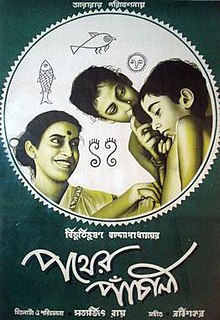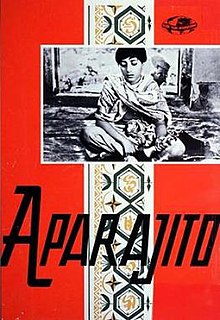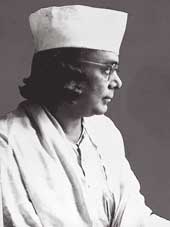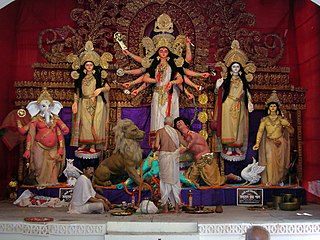Related Research Articles

West Bengal is a state in the eastern region of India along the Bay of Bengal. With over 91 million inhabitants, it is the fourth-most populous state and the fourteenth-largest state by area in India. Covering an area of 88,752 km2 (34,267 sq mi), it is also the eighth-most populous country subdivision of the world. Part of the Bengal region of the Indian subcontinent, it borders Bangladesh in the east, and Nepal and Bhutan in the north. It also borders the Indian states of Odisha, Jharkhand, Bihar, Sikkim and Assam. The state capital is Kolkata, the third-largest metropolis, and seventh largest city by population in India. West Bengal includes the Darjeeling Himalayan hill region, the Ganges delta, the Rarh region and the coastal Sundarbans. The state's main ethnic group are the Bengalis, with the Bengali Hindus forming the demographic majority.

The Apu Trilogy comprises three Indian Bengali language epic drama films directed by Satyajit Ray: Pather Panchali (1955), Aparajito (1956) and The World of Apu (1959). The original music for the films was composed by Ravi Shankar.

Pahela Baishakh or more commonly known as Pohela Boishakh in Bangladesh and Poila Boishakh in the Indian states of West Bengal, Tripura, Assam and parts of Jharkhand is the first day of the Bengali calendar which is also the official calendar of Bangladesh. This festival is celebrated on 14 April in Bangladesh and 15 April in the Indian states of West Bengal, Tripura, and Assam by Bengalis regardless of religious faith.

Pather Panchali is a 1955 Indian Bengali epic drama film written and directed by Satyajit Ray and produced by the Government of West Bengal. It is based on Bibhutibhushan Bandyopadhyay's 1929 Bengali novel of the same name and is Ray's directorial debut. It features Subir Banerjee, Kanu Banerjee, Karuna Banerjee, Uma Dasgupta and Chunibala Devi. The first film in The Apu Trilogy, Pather Panchali depicts the childhood of the protagonist Apu and his elder sister Durga and the harsh village life of their poor family.

Aparajito is a 1956 Indian Bengali-language epic drama film written and directed by Satyajit Ray (1921–1992), and is the second part of The Apu Trilogy. It is adapted from the first half of Bibhutibhushan Bannerjee's novel Aparajito. It starts off where the previous film Pather Panchali (1955) ended, with Apu's family moving to Varanasi, and chronicles Apu's life from childhood to adolescence in college.
Indian hip hop is a part of the South Asian hip hop culture, is a genre of popular music developed in India. Desi hip hop is a term for music and culture which combines the influences of hip hop and the Indian subcontinent; the term desi referring to the South Asian diaspora. The term has also come to be used as an alternative for rap music and even pop music which involves rappers of South Asian origins.
The Charyapada is a collection of mystical poems, songs of realization in the Vajrayana tradition of Buddhism from the tantric tradition in Assam, Bengal, Bihar and Odisha.

Bengali literature denotes the body of writings in the Bengali language. Bengali has developed over the course of roughly 1,300 years. The earliest extant work in Bengali literature is the Charyapada, a collection of Buddhist mystic songs in Old Bengali dating back to the 10th and 11th centuries. The timeline of Bengali literature is divided into three periods − ancient (650-1200), medieval (1200-1800) and modern. Medieval Bengali literature consists of various poetic genres, including Hindu religious scriptures, Islamic epics, Vaishnava texts, translations of Arabic, Persian and Sanskrit texts, and secular texts by Muslim poets. Novels were introduced in the mid-19th century. Nobel Laureate Rabindranath Tagore was the best known figure of Bengali literature to the world. Kazi Nazrul Islam, notable for his activism and anti-British literature, was described as the Rebel Poet and is now recognised as the National poet of Bangladesh.

Bengalis, also rendered as Bangalee or the Bengali people, are an Indo-Aryan ethnolinguistic group originating from and culturally affiliated with the Bengal region of South Asia. The native population is divided between the independent country Bangladesh and the Indian states of West Bengal, Tripura and Assam's Barak Valley. Most of them speak Bengali, a language from the Indo-Aryan language family.

Satyajit Ray (1921–1992), a Bengali film director from India, is well known for his contributions to Bengali literature. He created two of the most famous characters in Feluda the sleuth, and Professor Shonku the scientist. He wrote several short novels and stories in addition to those based on these two characters. His fiction was targeted mainly at younger readers, though it became popular among children and adults alike.

Rabindranath Tagore was a Bengali polymath – poet, writer, playwright, composer, philosopher, social reformer and painter. He reshaped Bengali literature and music as well as Indian art with Contextual Modernism in the late 19th and early 20th centuries. Author of the "profoundly sensitive, fresh and beautiful verse" of Gitanjali, he became in 1913 the first non-European to win the Nobel Prize in Literature. Tagore's poetic songs were viewed as spiritual and mercurial; however, his "elegant prose and magical poetry" remain largely unknown outside Bengal. He is sometimes referred to as "the Bard of Bengal".

Subir Banerjee is an Indian actor who played Apu in Satyajit Ray's Bengali film Pather Panchali, the first installment of The Apu Trilogy.

Satyajit Ray was an Indian film director, scriptwriter, documentary filmmaker, author, essayist, lyricist, magazine editor, illustrator, calligrapher, and music composer. Ray is widely considered one of the greatest filmmakers of all time in the world of cinema. He is celebrated for works such as The Apu Trilogy (1955–1959), The Music Room (1958), The Big City (1963) and Charulata (1964) etc. Ray was born in Calcutta to renowned writer Sukumar Ray who was prominent in the field of arts and literature. Starting his career as a commercial artist, he was drawn into independent filmmaking after meeting French filmmaker Jean Renoir and viewing Vittorio De Sica's Italian neorealist film Bicycle Thieves (1948) during a visit to London.

Bangladeshi Folk Literature constitutes a considerable portion of Bengali literature. Though it was created by illiterate communities and passed down orally from one generation to another it tends to flourish Bengali literature. Individual folk literature became a collective product and assumes the traditions, emotions, thoughts and values of the community.

Kavigan, Kobi Gaan, Kobi Lorai or Kabigan is a form of Bengali folk performance wherein folk poets sing and perform. A verbal duel among the poets, this mystic minstrels art was popular with rural folk form in nineteenth century in Bengal region, which includes the Indian state of West Bengal and Bangladesh.. The mythological themes from both Hindu and Muslims religious texts were commonly used for Kobi Gaan.

Bengali Hindus are an ethnic, linguistic and religious population who make up the majority in the Indian states of West Bengal, Andaman and Nicobar Islands, Tripura and Assam's Barak Valley region. In Bangladesh, they form the largest minority. They are adherents of Hinduism and are native to the Bengal region in the eastern part of the Indian subcontinent. Bengali Hindus speak Bengali, which belongs to the Indo-Aryan language family and adhere to Shaktism or Vaishnavism of their native religion Hinduism with some regional deities. There are significant numbers of Bengali-speaking Hindus in different Indian states. According to the census in 1881, 12.81 percent of Bengali Hindus belonged to the upper castes.

The Bengali Calendar or Bangla Calendar, colloquially, is a luni-solar calendar used in the Bengal region of the Indian subcontinent. A revised version of the calendar is the national and official calendar in Bangladesh and an earlier version of the calendar is followed in the Indian states of West Bengal, Tripura and Assam. The New Year in the Bengali calendar is known as Pohela Boishakh.
Baidya or Vaidya is a Hindu community of Bengal. A caste/jāti of Ayurvedic physicians, Baidyas have long occupied a place of pre-eminence in society alongside Brahmins and Kayasthas. In the colonial era, the Bhadraloks of Bengal were drawn from these three castes, who continue to maintain a collective hegemony in West Bengal.

Nadia Raj were a dynasty of Zamindars and the rulers of territories that are now part of the Nadia district region of West Bengal, India. Their seat was at the city of Krishnanagar, Nadia. The estate of Nadia Raj was estimated to cover an area of 8,161 square kilometres (3,151 sq mi).

Sylheti literature is the literary works of Sylheti language in Eastern and Sylheti Nagri. Chorjapod is believed to be the oldest collection of Sylheti along with Assamese, Bengali, Bhojpuri, Odia, Magahi, Maithili, and other languages. Halat-un-Nabi, a puthi written by Sadeq Ali is considered to be the most prominent literature in Sylheti Nagri.
References
- 1 2 Roy, Manisha (2010-02-15). Bengali Women. University of Chicago Press. pp. 191–. ISBN 9780226230443 . Retrieved 29 August 2015.
- ↑ Datta, Utpal (1992-01-01). Girish Chandra Ghosh. Sahitya Akademi. pp. 8–. ISBN 9788172011970 . Retrieved 29 August 2015.
- ↑ Sengupta, Nitish K. (2011-01-01). Land of Two Rivers: A History of Bengal from the Mahabharata to Mujib. Penguin Books India. pp. 113–. ISBN 9780143416784 . Retrieved 29 August 2015.
- ↑ Yamin, Mohammed. Impact of Islam on Orissan Culture. Readworthy. pp. 61–. ISBN 9789350181027 . Retrieved 29 August 2015.
- ↑ Chakrabarti, Kunal; Chakrabarti, Shubhra (2013-08-22). Historical Dictionary of the Bengalis. Scarecrow Press. pp. 465–. ISBN 9780810880245 . Retrieved 29 August 2015.
- ↑ Barthakur, Dilip Ranjan (2003). The Music and Musical Instruments of North Eastern India. Mittal Publications. pp. 42–. ISBN 9788170998815 . Retrieved 29 August 2015.